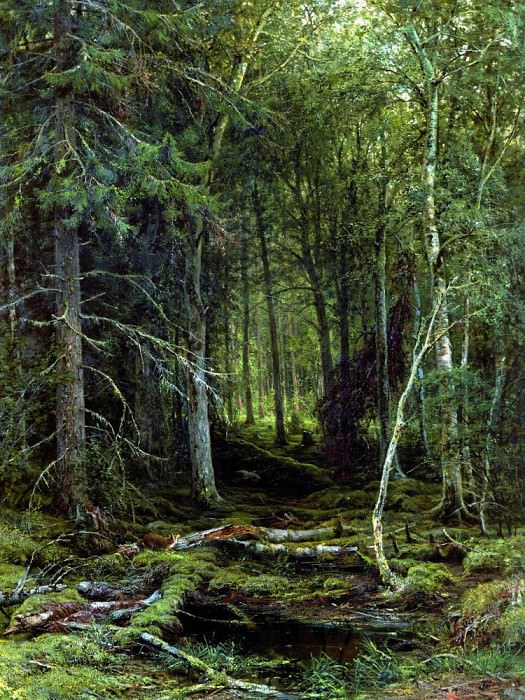Backwoods 1872 209h161 Ivan Ivanovich Shishkin (1832-1898)
Ivan Ivanovich Shishkin – Backwoods 1872 209h161
Edit attribution
Download full size: 750×1000 px (0,3 Mb)
Painter: Ivan Ivanovich Shishkin
Created in 1872, the canvas once again confirms the artist’s love of nature and especially of the forest. He depicted it at noon, in clear weather, where light plays in the leaves. But there is another version of the forest thicket: full of darkness and the unexplored. Such a vision is capable of evoking awe or even fear of the unknown in the viewer. It is these feelings that Shishkin awakens with his painting "Forest wilderness".
Description of Ivan Shishkin’s painting "The Forest Wilderness".
Created in 1872, the canvas once again confirms the artist’s love of nature and especially of the forest. He depicted it at noon, in clear weather, where light plays in the leaves. But there is another version of the forest thicket: full of darkness and the unexplored.
Such a vision is capable of evoking awe or even fear of the unknown in the viewer. It is these feelings that Shishkin awakens with his painting "Forest wilderness". It was the sensuality of the painting that earned the master the title of professor, immediately upon completion of his work on it.
Looking at the woods, few would want to be in a similar place, and even more alone. But not immediately the viewer can see a full-fledged forest in the depicted landscape. The artist conceived the picture for a long time consideration by the viewer. He has to feel what he sees, to get used to it, to look deeper.
The painting is full of small details that can escape a fleeting glance. There is a fox and a duck, which escapes from the clutches of the cunning predator. The artist was scolded by his fellow painters more than once for such detailing, calling the picture a painted picture, and the details piecemeal into the overall image. But the detailing of the depicted has never affected the integrity of the image being created.
The depicted forest does not evoke gusts of inspiration or lyrical reflections, but still it appears to the viewer strikingly rich in its colors and varied in its details. These details beckon one to gaze long and closely at the treasures that the forest hides in the shadows of its branches. Then the viewer, absorbed in the mysteries, imperceptibly dissolves and only nature remains around.
And so Shishkin created this landscape as an embodiment of his own spiritual impulses, as a reflection of his own view of the infinitely beautiful element of nature: the dense northern forest, untouched so far by the hand of man.
Кому понравилось
Пожалуйста, подождите
На эту операцию может потребоваться несколько секунд.
Информация появится в новом окне,
если открытие новых окон не запрещено в настройках вашего браузера.
You need to login
Для работы с коллекциями – пожалуйста, войдите в аккаунт (open in new window).




















COMMENTS: 2 Ответы
Даже лисица, боится напиться.
Это не лисица
You cannot comment Why?
I see a lush, densely packed forest scene bathed in dappled sunlight. Towering trees, thick with foliage, create a canopy that filters the light, casting deep shadows and illuminating patches of the forest floor. The ground is carpeted with moss, fallen logs, and undergrowth, giving it a wild, untamed feel. A small, dark stream or pool of water is visible in the foreground, reflecting the surrounding greenery. The overall impression is one of peace and tranquility within a vibrant natural environment.
Subtexts:
The painting evokes a sense of natures grandeur and power, highlighting the beauty and scale of an untouched forest. It can also be seen as a reflection of solitude and introspection, inviting the viewer to contemplate their place within the vastness of the natural world. The fallen logs and moss-covered ground suggest the cycle of life and decay, a constant process of renewal within the forest. The play of light and shadow might symbolize mystery and hidden depths, hinting at the unseen aspects of nature. Additionally, in the context of 19th-century Russian art, such depictions of the wilderness often celebrated national identity and the romantic ideal of the unspoiled homeland.